M5A1 Stuart Light Tank "U-Go" Restoration
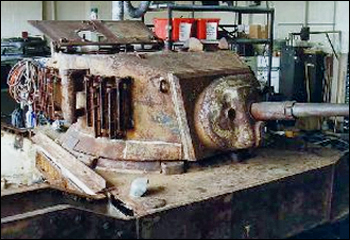
After nearly five years of painstaking effort, the Fort Snelling Military Museum Volunteers completed the restoration of an M5A1 Stuart light tank to mint operating condition. This particular M5A1 tank was manufactured in 1943 in Racine, Wisconsin by the Massey Harris Company, and bears the serial number 9876. The Army registration number of this tank was 3059180. Based on battle casualty reports referencing similarly numbered tanks, it is believed that #9876 may have seen combat in support of the U.S. First Army in the ETO. While little of this vehicle's exact history is known, a rebuild plate on the vehicle clearly establishes that this tank was refitted in Italy during the postwar period.
There is real historical significance to this tank's 752nd Tank Battalion markings and the "U-Go" name on this M5A1 tank. Fort Snelling Military Museum was affiliated with the US Army's 88th Regional Support Command, whose lineage traces to the famed 88th Infantry ("Blue Devils") Division. The 752nd Tank Battalion supported the 88th Infantry Division in combat in Italy, so the choice of markings seemed very logical and appropriate. After obtaining the necessary approvals, the Museum restored this M5A1 as a vehicle of the 752nd Tank Battalion's D Company, which played an instrumental and perhps even heroic role in support of the 88th Infantry during the battle of Verona, Italy in April 1945.
Specifically, this M5A1 has been marked as Tank D9, nicknamed "U-Go," which was one of five M5A1 tanks in the 2nd Platoon that participated in the battle of Verona. With the medium tanks of the entire 5th Army unable to cross the Po River until pontoon bridges could be built, "U-Go" and the four other light tanks in the platoon were floated across the swiftly flowing river on rafts, and became the armored portion of an 88th task force that ran in fast pursuit of the enemy in their attempt to escape across the Brenner Pass to Germany. "U-Go" took part in an amazingly rapid pursuit of the enemy, engaging in several firefights along the way, and ultimately routing the disorganized German army in the heart of Verona. The following morning, the crossroads where this action took place was nicknamed "Bloody Corner" by the GIs, for obvious reasons."U-Go" was commanded by Sgt. Clarence Johannes, with crewmembers Joe Acquista (Gunner), Willon Underhill (Driver), and Walter Lupkes (Assistant Driver/Bow Gunner). On 25 May 2005, FSMM and the US Army's 88th Reserve Readiness Command conducted a ceremony dedicating the restored M5A1 to these crew members. Walter Lupkes and his family were proudly in attendance.
The story of "U-Go," its crew, and the action they saw in Verona was constructed by 752 historian and webmaster Bob Holt, based on phone interviews with Walter Lupkes in June, July, and November 2002. We are exceptionally grateful for Walter's willingness to share his recollections, photos, and memorabilia in the development of this story, and for the opportunity to integrate this material into FSMM's static display.
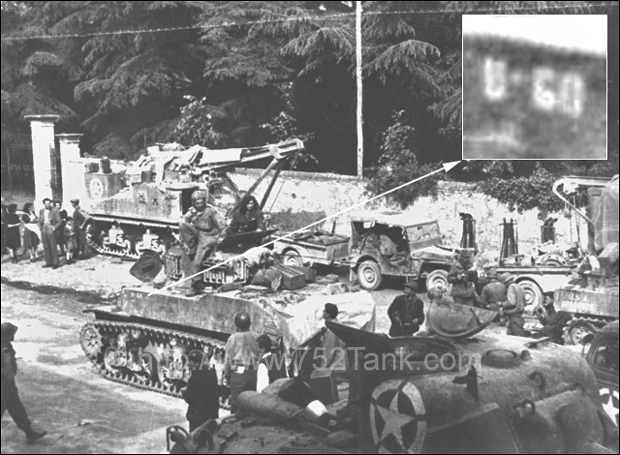 |
A photograph of "U-Go," taken by an Italian civilian as the 752nd liberated Cornuda on 30 April 1945. The tanker standing on top of "U-Go" appears to be the gunner, Joe Acquista. This street is known today as Via XXX Aprile 1945, in honor of the liberation of Cornuda. |
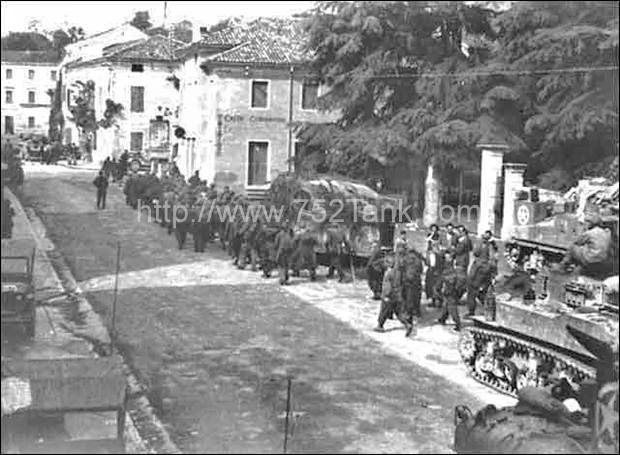 |
Another photo of "U-Go" in the same location, as German prisoners are escorted to the rear. The Caffe Commercio shown in the background still operates today under the same name. |
The following photographs provide a sense of just how extensive this restoration process was. Quite literally, every nut and bolt and accessory was removed, cleaned, and painted, and meticulously re-assembled.
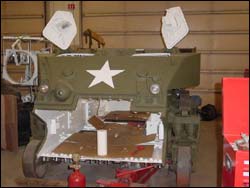 |
The hull and interior of the M5A1 have been painted. The drive train, transmission cover, turret, and tracks will be installed later. Finishing touches of the restoration project will include painting the insides of the drivers' hatches olive drab, which was done in combat theaters to maximize camouflage effects. |
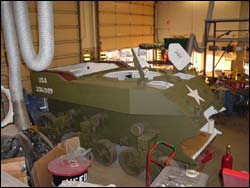 |
A side view of the M5A1 under restoration. Note the "USA" and registration markings to the rear of the hull's side. Also note the rise in height of the rear deck above the engine compartment, which was characteristic of the M5 series. |
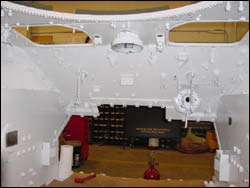 |
A view of the drivers' positions inside the hull, with the turret opening at the top of the photo. The pristine paint job reflects the condition of the M5A1 as it would have rolled off the assembly line. Tank interiors were painted white or light green in order to maximize the reflected light inside the dimly lit tank. Hatch interiors, which would be exposed when opened, were painted olive drab. Looks pretty roomy in this photo, but quarters were quite cramped in a fully assembled and loaded M5A1. |
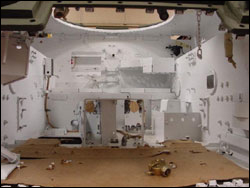 |
Looking through the front hull toward the rear of the crew compartment. At this point, the interior is beginning to be outfitted. The area still looks fairly spacious, but much of this space will be taken up by the turret basket, drive train, ammunition storage, and drivers' seats. |
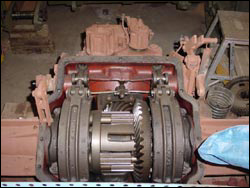 |
Excellent view of the inside of the transfer unit after reconditioning. The transfer unit accepted two driveshafts from the twin Cadillac V-8 110 net horsepower engines and Hydromatic automatic transmissions. The transfer unit then distributed the power to the front drive sprockets. The M5A1's Hydromatic transmissions had four forward speeds and one reverse speed, and the transfer unit had two speeds. |
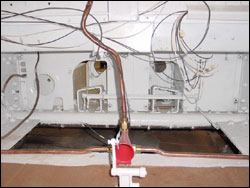 |
The engine compartment has been wired and is nearly ready to accept the engines and transmissions. The view is toward the crew compartment bulkhead. The two driveshafts passed through the openings at the center of the photo. The large rectangular opening in the hull floor allowed for servicing/removal of the transmissions, and was protected by a large bolt-on plate. The red object is one of several fire extinguisher discharge horns located in the engine compartment. |
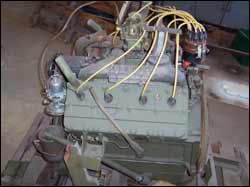 |
One of U-Go's two engines is receiving its final touches prior to installation. Each 246 cubic-inch engine was made by Cadillac, and produced 148 gross horsepower (110 net horsepower) and 280 gross foot-pounds of torque (244 net foot-pounds). Each Cadillac engine ran on 80 octane gasoline, held 8 quarts of oil, and weighed 584 pounds when completely outfitted. |
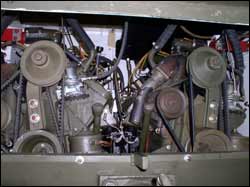 |
The two Cadillac engines have now been installed. Though it is a tight fit, there is sufficient room for conducting basic maintenance and minor repair work. The first signs of life occurred on 26 May 2005, when the electrical system was switched on. On 1 March 2006, both engines were fired up together for the first time, and "U-Go" enjoyed its first operational test drive on 23 April 2006 after sitting idle for many decades. |
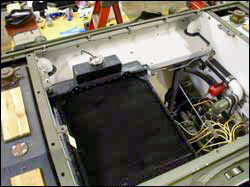 |
One of the radiators has been installed above one of U-Go's twin engines. The radiators were installed horizontally, with the radiator fill caps located to the rear. The radiators were identical, and the two cooling systems were completely independent of one another. The capacity of each cooling system was 35 quarts. |
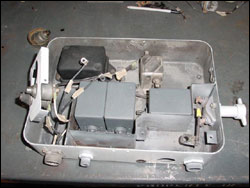 |
This photo shows the inside of the "Apparatus Box," which housed various electrical components. It was mounted inside the tank on the left sponson. Sticking out of the box on the left side of the photo are the electrical start and stop buttons, which will be mounted to a cover which fits over the box. Note the fittings for the electrical cabling on the bottom and side of the box. |
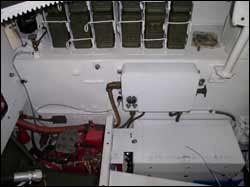 |
This photo shows the electrical apparatus box (seen above) installed. It is located just ahead of the firewall and the left engine. The box for the 12-volt battery is located just below the apparatus box. The red colored equipment is the auxiliary generator, used for charging the battery when the main engines are idle, or to supplement the battery during periods of heavy current draw. |
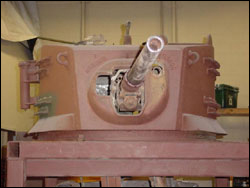 |
Front view of the turret of the M5A1. The turret has been primered before receiving its final coats of olive drab. The 37mm main gun provided little effective firepower. The hole at the top corner of the gun mantlet is for the main gun sighting scope. On the turret's right side (left side of picture) is the mount for the external .30 caliber machine gun. |
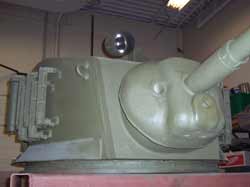 |
A good frontal view of the turret after it received a coat of olive drab paint. The main gun mantlet shield has been installed, and the grousers have been mounted on their racks. The searchlight has been mounted on the roof of the turret. |
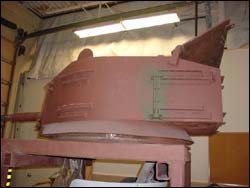 |
Side view of the M5A1 turret. The horizontal brackets on the side of the turret are for stowing the track grousers. Note the flared track race shield at the bottom of the turret, designed to prevent bullet splash from jamming the track race. |
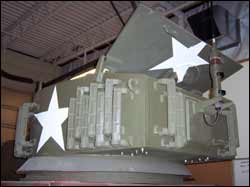 |
The turret's exterior has now been completed. Allied stars have been painted over the olive drab surface, and grousers have been mounted to the side and rear racks. The radio antenna base and mast have also been attached to the radio plate on the rear of the turret. |
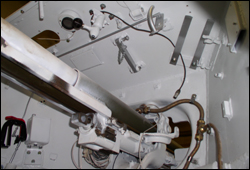 |
A view of the inside of the turret before all of the components have been installed. The breech ring of the 37mm main gun is clearly visible. The red and black object on the lower left is the firing lever. The silver object on the turret roof immediately above the breech is the gun's travel lock. Yet to be installed are the breech guard assembly, gyro and stabilizer controls, periscopes, main gun gear box, recoil mechanism, oil reservoir, sighting scope, and .30 coaxial machine gun. |
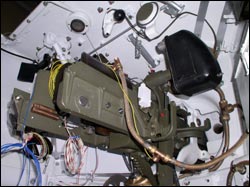 |
The right side of the breech assembly, looking toward the front of the turret. The black breech ring of the 37mm M6 main gun is barely visible inside the olive drab combination gun mount M23. The black box to the right of the breech assembly is the gyro control, which stabilized the main gun when the tank was firing on the run. Copper conduit houses the wiring, which is about to be connected to the switches and solenoids. |
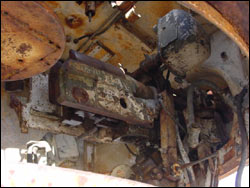 |
The right side of the breech assembly at the beginning of the restoration project. This is typical of the condition of the entire interior and exterior of the tank. Light rust was everywhere, and many parts and accessories had been missing for some time. Compare this to the photo above, and imagine the thousands of hours of labor involved in restoring an entire tank! |
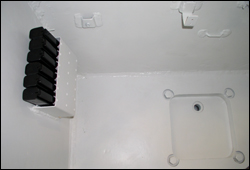 |
A view of the rear turret bustle looks very spacious with the radio removed. The black items to the left are clips for Thompson submachine gun ammunition. The hole in the rectangular plate on the rear or the turret is a pass-through for the antenna cable. The method of removing the 37mm main gun was to remove the radio, unbolt the small plate, and pass the main gun through the rectangular opening in the rear of the turret. |
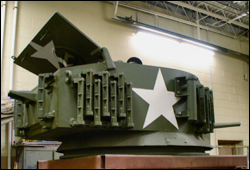 |
The turret has been painted and the grousers are now in place in the racks on the side of the turret. The antenna bracket protrudes from the rear of the turret. Note the absence of a pistol port, which had been included in the original design but was eliminated very early in the production run. |
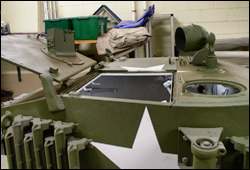 |
A good view of the top of the turret. Note the nearly square turret roof doors, one of which is open (both are open in the photo above). The round periscope opening in front of the commander's roof door will house a rotating periscope. The mount for the .30 machine gun is shown at the bottom right of the photo. |
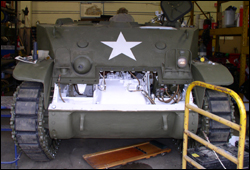 |
It's beginning to look more like a tank! The newly refurbished T16E2 rubber tracks are now in place. The lower front armor plate has been installed, and the hydraulic lines have been connected. Some of the hull fittings such as the driver's side service/blackout lights are in place now. |
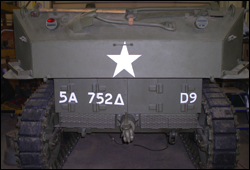 |
The 752nd lettering has been applied to the rear plate. The letters are regulation 3" high, based on fonts that appeared in the Army field marking regulations dated 27 January 1944. The letters "5A" signify the Fifth Army, and "752Δ" denotes the 752nd Tank Battalion. The vehicle number D9 is stenciled on the right side of the engine compartment door, indicating the 9th tank of D Company, and the 4th tank of the 2nd Platoon. |
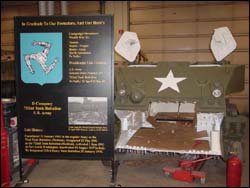 |
The restored M5A1 was destined to become a rolling educational and recruiting exhibit, appearing at various locations across the U.S. A storyboard provides the 752nd Distinctive Insignia, some information about the M5A1 tank, and a photo of the 752nd Tank Battalion in the Bologna town square. The display kiosk includes a professionally narrated reading of the story of the battle for Verona, where the 752nd D Company tankers played a critical role. |
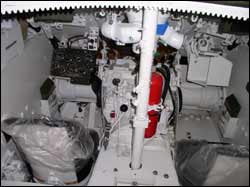 |
The driver's compartment is nearly completed, and plastic covers protect the seats as if "U-Go" was a brand new car awaiting delivery. The driver's seat is to the left, where the driver's control levers can be seen. The assistant driver/bow gunner's seat is to the right. The teeth for the turret ring gear can be seen at the top of the photo. |
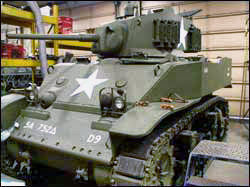 |
On 13 May 2006, a major milestone in the project was achieved when U-Go's turret was re-installed. Much detail work has been completed, such as the mounting of leather tool straps on the front of the tank. U-Go's name, which had been previously stenciled mid-sponson, has now been moved toward the front of the tank based on 1945 photos of "U-Go" that were discovered in Italy. Some mechanical detail work still needs to be done, but the project is nearing completion. |
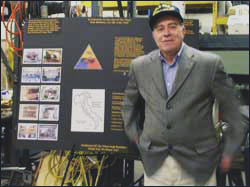 |
The late Walter Lupkes stands beside the near-completed M5A1 at a dedication ceremony on 25 May 2005. Mr. Lupkes was an assistant driver/ bow gunner in a 752nd Tank Battalion M5A1 named "U-Go," and the Fort Snelling M5A1 was named in honor of his tank. Mr. Lupkes and "U-Go" saw action in the Po Valley. Click here to learn about some of the action they saw in Verona. |
Back
in Army Service
U-Go remained in the collection until 2011, when a Base Realignment and Closure program forced the closure of the Fort Snelling Military Museum. Fortunately for all, "U-Go" was transferred to the U.S. Army Armor & Cavalry Collection at Fort Benning, Georgia, where she remains on display in her 752nd Tank Battalion markings, alongside a wide range of other historic fighting vehicles. There is no greater place of honor for "U-Go" to reside.
This particular vehicle was produced almost 80 years
ago by the folks from the Massey Harris tractor manufacturing plant in
Racine, Wisconsin. If they could have ever known that one of their
tanks would still be in service with the US Army in 2022, they'd
be simply amazed.
On 10 June 2006, "U-Go" was readied for transport to its first fully
operational showing. The tank and its support team were tasked with
supporting a Total Army Involvement In Recruiting project. This directed
mission was executed on 10 June in support of the US Army Recruiting
Commands' Minneapolis Recruiting Battalion. "U-Go" performed her first mission flawlessly, and continued to successfully and impressively perform similar missions in parades and recruitment exercises over for the next five years.
Congratulations to all who donated their time, energy, passion, and talent to bring this vehicle back to life, and to all those who continue to serve as its caretakers!
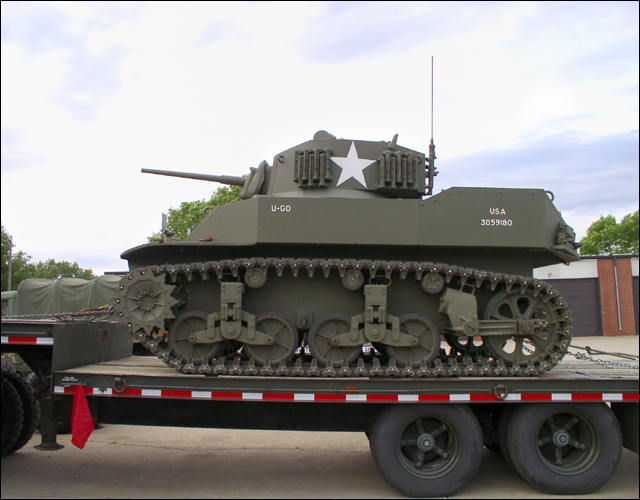 |
Freshly restored U-Go on a trailer on 10 June 2006, ready for her first mission as part of a Total Army Involvement In Recruiting project, supporting the U.S. Army Recruiting Commands' Minneapolis Recruiting Battalion. |
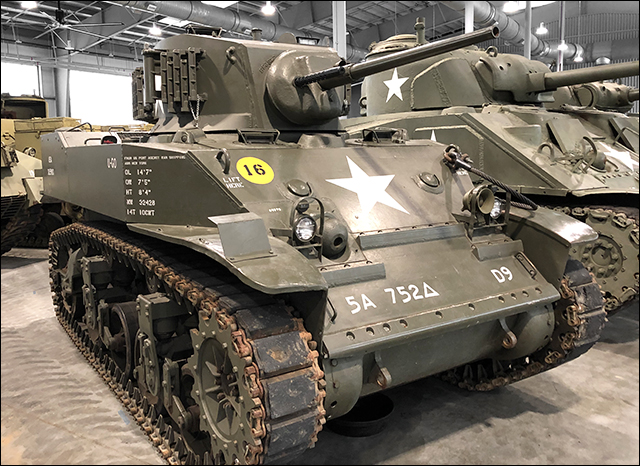 |
U-Go proudly represents the 752nd Tank Battalion at the U.S. Army Armor and Cavalry Collection at Fort Benning, GA, 24 June 2021. She is now part of an impressive array of beautifully restored WWII American armored fighting vehicles. |
This web page was originally created with the approval of Fort Snelling Military Volunteers, Inc., an independent private organization formed in the State of Minnesota for the express purpose of supporting and providing services to the Fort Snelling Military Museum. This strictly volunteer group was not otherwise affiliated with the US Army Reserve, the US Army's 88th Regional Support Command, the United States Government, the US Army Center of Military History, or the Fort Snelling Military Museum.